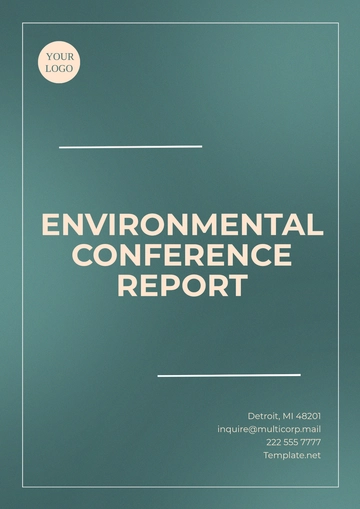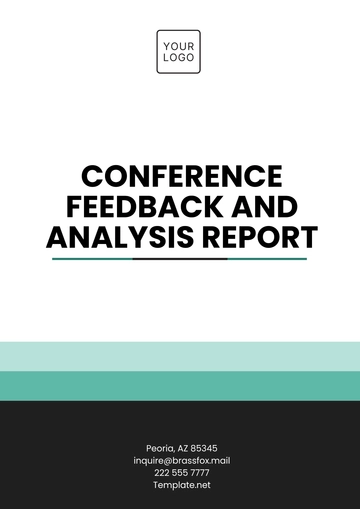Free Environmental Conference Report

Prepared by:
[YOUR NAME]
[YOUR COMPANY NAME]
Introduction
The 2050 Global Environmental Conference was held from October 10th to October 12th, 2050, in New York City, bringing together over 500 environmental experts, policymakers, activists, industry leaders, and researchers from around the world. The primary aim of the conference was to address the most pressing environmental issues of our time, including climate change, biodiversity loss, and sustainable development, and to identify actionable solutions through collaborative efforts and discussions.
This report summarizes the key discussions, outcomes, and recommendations from the event, highlighting the major topics covered and outlining the next steps for stakeholders involved in environmental protection and sustainability.
Key Themes and Discussions
1. Climate Change and Global Mitigation Strategies
One of the central topics of the conference was climate change mitigation, with a focus on reducing greenhouse gas emissions and transitioning to renewable energy sources.
Global Carbon Neutrality: Experts discussed pathways for achieving global carbon neutrality by 2050, emphasizing the importance of policy frameworks that support the transition to green energy.
Carbon Capture and Storage (CCS) Technologies: A session dedicated to CCS technologies provided insights into the potential of these technologies to reduce emissions from hard-to-abate sectors such as heavy industry and transportation.
International Collaboration: Panelists emphasized the need for stronger international collaboration, particularly through initiatives such as the Paris Agreement, to ensure climate commitments are met globally.
2. Biodiversity Loss and Conservation
Biodiversity loss remains one of the most critical environmental challenges, with significant implications for ecosystem services, food security, and climate resilience.
Protecting Ecosystems: Discussions focused on strategies for protecting critical ecosystems such as forests, wetlands, and coral reefs, which provide essential services such as carbon sequestration and habitat for wildlife.
Rewilding and Conservation Efforts: Several organizations shared successful case studies of rewilding initiatives, where the restoration of native species and ecosystems is leading to positive environmental outcomes.
The Role of Indigenous Knowledge: A panel highlighted the importance of integrating Indigenous knowledge into conservation efforts, particularly in areas such as land management and sustainable resource use.
3. Sustainable Development and Green Economy
The conference also delved into the connection between sustainability and economic development, discussing how the green economy can create jobs, improve quality of life, and reduce environmental degradation.
Circular Economy Models: Several sessions highlighted the growing adoption of circular economy models, where waste is minimized, and resources are reused, recycled, or remanufactured.
Sustainable Agriculture: Experts discussed innovations in agriculture aimed at reducing environmental impacts, such as regenerative farming practices, and the role of technology in supporting sustainable food systems.
Green Finance: Financial institutions shared insights into how green bonds, sustainable investing, and ESG (environmental, social, and governance) criteria are shaping investments in sustainability projects worldwide.
Key Outcomes and Recommendations
1. Commitment to Global Carbon Neutrality by 2050
It was agreed that nations must accelerate their efforts to achieve carbon neutrality by 2050. The conference emphasized the need for:
Stronger regulatory frameworks to ensure industries and nations meet emissions reduction targets.
Investment in green infrastructure, such as renewable energy plants and electric vehicle charging networks, to support the transition to low-carbon economies.
2. Scaling Up Conservation Efforts
The conference called for urgent action to halt biodiversity loss by:
Expanding the protection of marine and terrestrial protected areas to cover at least 30% of the planet by 2050.
Supporting the restoration of degraded ecosystems, focusing on forest restoration and wetland rehabilitation, to enhance carbon sequestration and biodiversity.
Integrating conservation with community development by involving local communities in decision-making and ensuring their participation in conservation initiatives.
3. Promotion of Circular Economy Practices
Participants agreed on the importance of promoting circular economy models by:
Implementing extended producer responsibility (EPR) policies to reduce waste and encourage recycling.
Supporting innovation in materials science to create products that are easier to recycle and use fewer natural resources.
Encouraging businesses to adopt sustainable sourcing practices, particularly in the textile and electronics sectors, to reduce environmental harm.
4. Investment in Green Technologies
A key recommendation was the need to increase investment in emerging green technologies, including:
Carbon capture and utilization (CCU) technologies to turn captured carbon into valuable products.
Green hydrogen is an alternative to fossil fuels, particularly in industries that are hard to electrify, such as heavy transportation and industrial manufacturing.
Nature-based solutions that leverage natural systems to address environmental challenges, such as flood management and carbon sequestration.
Action Plan
Action Item | Responsible Parties | Timeline | Expected Outcome |
|---|---|---|---|
Develop carbon-neutral policies | Governments, International Bodies | By 2050 | Achieve net-zero emissions by 2050 |
Expand conservation areas | Governments, NGOs | Ongoing | Protect 30% of the planet's land and oceans by 2050 |
Promote circular economy | Industry Leaders, Policymakers | By 2050 | Transition to a circular economy with reduced waste |
Invest in green technologies | Governments, Private Sector | Ongoing | Boost the development and adoption of sustainable technologies |
Conclusion
The 2050 Global Environmental Conference successfully highlighted the critical issues facing the planet and provided actionable solutions that can help reverse environmental degradation. While significant challenges remain, the collective commitment and collaboration among governments, businesses, researchers, and communities offer a hopeful path forward.
Moving forward, the recommendations and action items discussed will guide global efforts towards a more sustainable and resilient future. Continued collaboration, investment in green technologies, and strong policy frameworks will be essential to achieving the ambitious goals outlined during the conference.
- 100% Customizable, free editor
- Access 1 Million+ Templates, photo’s & graphics
- Download or share as a template
- Click and replace photos, graphics, text, backgrounds
- Resize, crop, AI write & more
- Access advanced editor
The Environmental Conference Report Template from Template.net is fully editable and customizable, designed to meet the specific needs of your environmental events. With our AI Editor Tool, you can easily modify content, design, and layout for a professional, polished report. Ideal for documenting sustainability initiatives, this template ensures clarity and impact in your presentation.
You may also like
- Sales Report
- Daily Report
- Project Report
- Business Report
- Weekly Report
- Incident Report
- Annual Report
- Report Layout
- Report Design
- Progress Report
- Marketing Report
- Company Report
- Monthly Report
- Audit Report
- Status Report
- School Report
- Reports Hr
- Management Report
- Project Status Report
- Handover Report
- Health And Safety Report
- Restaurant Report
- Construction Report
- Research Report
- Evaluation Report
- Investigation Report
- Employee Report
- Advertising Report
- Weekly Status Report
- Project Management Report
- Finance Report
- Service Report
- Technical Report
- Meeting Report
- Quarterly Report
- Inspection Report
- Medical Report
- Test Report
- Summary Report
- Inventory Report
- Valuation Report
- Operations Report
- Payroll Report
- Training Report
- Job Report
- Case Report
- Performance Report
- Board Report
- Internal Audit Report
- Student Report
- Monthly Management Report
- Small Business Report
- Accident Report
- Call Center Report
- Activity Report
- IT and Software Report
- Internship Report
- Visit Report
- Product Report
- Book Report
- Property Report
- Recruitment Report
- University Report
- Event Report
- SEO Report
- Conference Report
- Narrative Report
- Nursing Home Report
- Preschool Report
- Call Report
- Customer Report
- Employee Incident Report
- Accomplishment Report
- Social Media Report
- Work From Home Report
- Security Report
- Damage Report
- Quality Report
- Internal Report
- Nurse Report
- Real Estate Report
- Hotel Report
- Equipment Report
- Credit Report
- Field Report
- Non Profit Report
- Maintenance Report
- News Report
- Survey Report
- Executive Report
- Law Firm Report
- Advertising Agency Report
- Interior Design Report
- Travel Agency Report
- Stock Report
- Salon Report
- Bug Report
- Workplace Report
- Action Report
- Investor Report
- Cleaning Services Report
- Consulting Report
- Freelancer Report
- Site Visit Report
- Trip Report
- Classroom Observation Report
- Vehicle Report
- Final Report
- Software Report





























